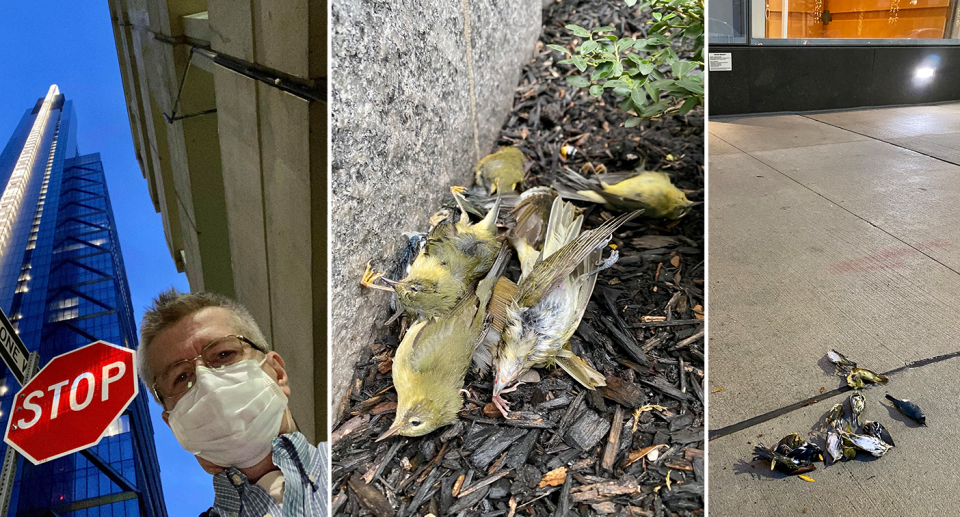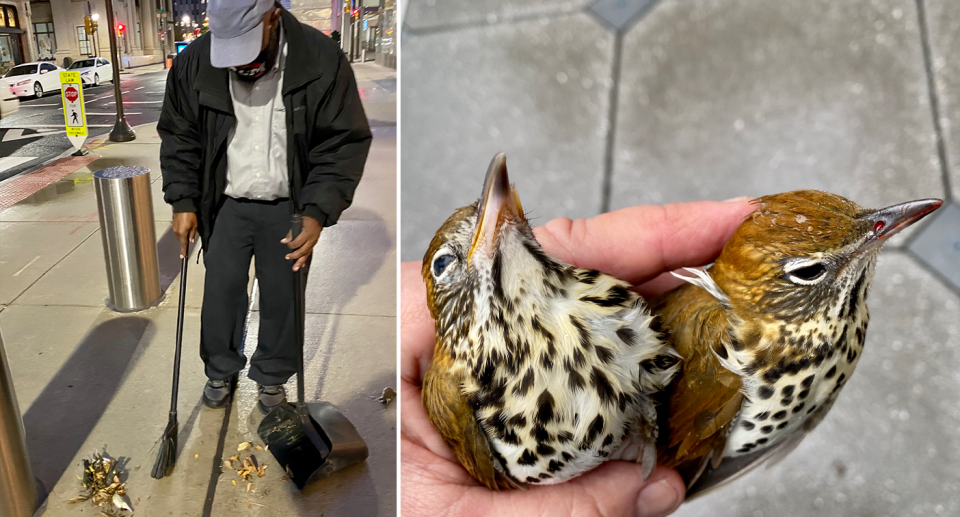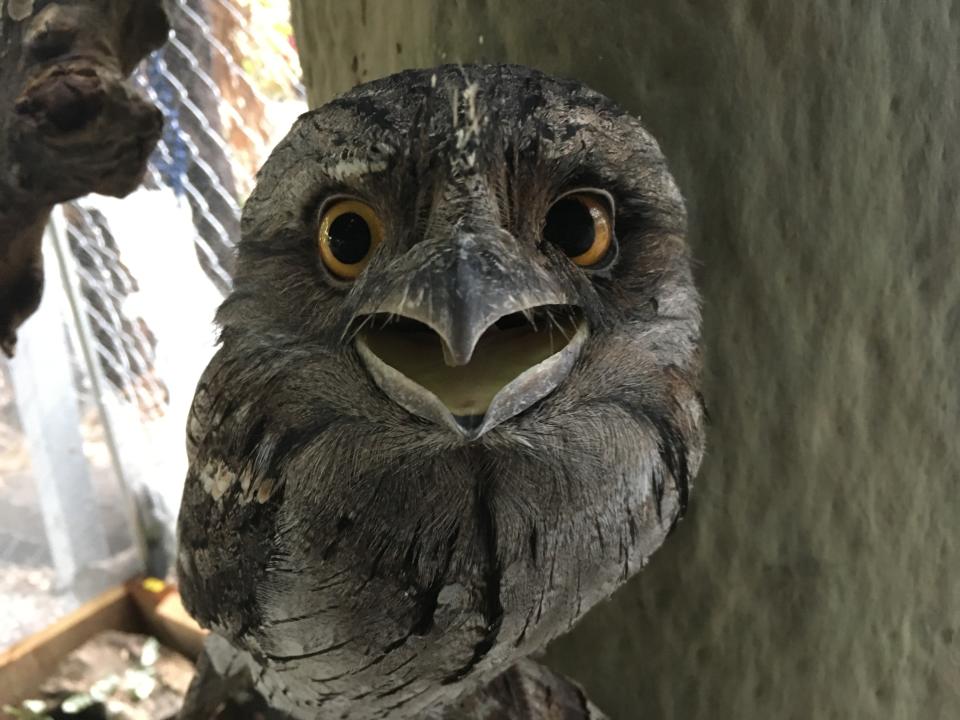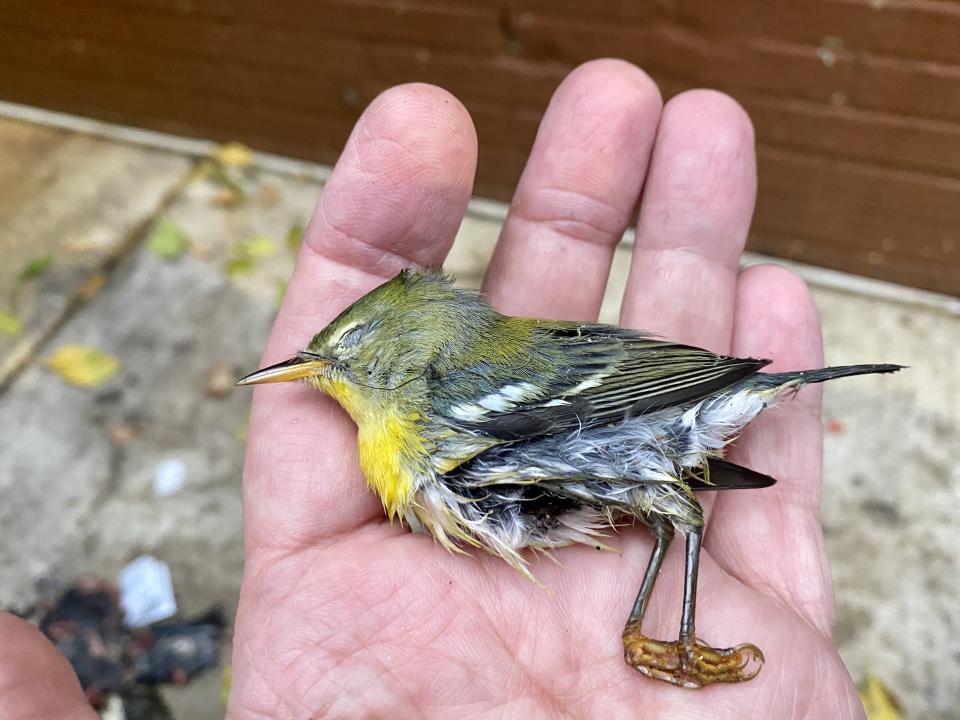Tragic reason hundreds of birds found dead next to luxury hotel
WARNING – DISTRESSING CONTENT: Finding a sea of dead and dying songbirds in the heart of the city has left a retiree ‘shaking’ with grief.
It wouldn’t be unusual for 71-year-old Stephen Maciejewski to recover the bodies of 30 birds as part of his voluntary work cataloguing deaths across the city during migration events.
On the morning of October 2, the death toll was far greater than anyone there had seen in the state for 70 years.

Beginning at 5.30am, Mr Maciejewski began collecting the 400 bodies of colourful migratory birds, lying at the base of buildings in the heart of the US city of Philadelphia in Pennsylvania.
Those recovered were just the tip of the iceberg with estimates from conservation group Audubon Pennsylvania suggesting between 1000 and 1500 were killed in a single night.
Flashbacks continue to haunt Mr Maciejewski and his voice becomes soft and shaky as he recalls the catastrophe.
“At one point my body just started shaking, I didn't know what was happening,” the bird lover told Yahoo News Australia from his home in Pennsylvania.
“I just couldn't believe there is so much death everywhere.”
Volunteers rush to save birds before they’re thrown in the trash
Assisted by a member of Audubon Pennsylvania, Mr Maciejewski hurried to recover as many birds as they could before the street sweepers and large industrial vacuums sucked up the bodies.
He describes the birds as being littered around several high rise buildings, including at the base and on the sub-roof of a large luxury hotel.

Luckily for Mr Maciejewski, his time befriending a number of the city’s maintenance workers and hotel staff on previous days paid off, and many of them saved the dead birds for him.
“Horrifically one guy came with his dust pan, and he dumped 75 songbirds in front of me,” Mr Maciejewski said.
“I could not believe it, some where alive amongst the dead.”
Those still breathing were given triage, but their survival rate was not high.
Sound from car horns and engines filled the air, but the songbirds were silent.

Mr Maciejewski laid the bodies of the fallen birds down on the dirty pavement and snapped a photo of the destruction.
The image shows the terrible contrast between the brightly coloured feathers and the dull city they had collided with.
The dead were bagged, tagged and sent to the Academy and Natural Sciences for research.
There were so many birds that cataloguing supplies began to run short.

“To see them in your hands, these beautiful birds, their bodies still warm, and you can't even process them one by one,” Mr Maciejewski said.
“There's some dignity giving each one the individual number and putting it in the bag, but I had to put like, 50 of them in one big plastic bag.
“It was sacrilegious.”
Experts suggest reason for bird deaths
The birds are believed to have died after flying into buildings that stretch across the Philadelphia skyline.
While North Carolina experienced a similar event last year, a mass bird mortality in Pennsylvania hasn’t been recorded since 1948.

Heavy cloud and rain may have affected visibility during the bird migration before the sun rose on October 2, and could have contributed to the sudden spike in deaths.
Building collisions are thought to be responsible for hundreds of millions of deaths a year in the US, where skyscrapers block the paths of many migratory bird species.
Australia’s land based birds are largely territorial, so migratory birds dying en masse from window collisions are not a common occurrence, but the isolated deaths do stack up.

Locally, 269 species of birds have been recorded dying from impact with glass - including endangered swift parrots which have flown into clear fencing.
Data provided by BirdLife Australia shows the most common birds registered as having died from hitting glass in Australia are rainbow lorikeets, crimson rosellas, magpies, spotted doves and sacred kingfishers.
Common mistakes Australian builders make
Monica Awasthy from BirdLife Australia notes that bright lights inside buildings can disorientate birds and lead to collisions.
Often the bird can’t see the building because it’s clad in reflective glass, while another killer can be the bird seeing straight to the other side, and believing there is a pathway through.
Planting of trees too close to glass is a particular problem when it comes to bird welfare in Australia, according to Ms Awasthy.

Staggering bushfire report reveals government's 'horrifying' effort to save wildlife
'Smoke and loud bangs': Endangered bats at risk as relocations go ahead
'Something’s going to give': Platypus staring down the barrel of extinction
Devastated residents dread cull of beloved kangaroos living amongst them
The battle to stop the horrific fate awaiting orphaned joeys
“We plant things that are bird friendly, too close to the buildings and it doesn't give the birds a chance to slow down,” she told Yahoo news Australia.
“We're trying to green our cities, so we'll do things like put on green roofs and we'll put trees inside buildings or vegetation on the outside, it’s well meaning, but it can actually have a detrimental effect.
“It's the same with people in their homes. We might put a bird bath or a bird feeder just too close to the house, and the bird just doesn't see the danger.”
Simple solution to stopping window collisions
Birds can reach jaw dropping speeds and often need a lot of time to come to a complete stop, so there are a few simple measures people can take to help them see the danger sooner.

Ms Awasthy said one of the lowest cost solutions is to put markings on existing glass to show the bird that it’s not a flight path.
Horizontal markers 10cm apart that are either solid or UV coloured will help even the smallest birds avoid collisions.
Avian species see the world in a different colour spectrum to humans and people building new homes or even large buildings can opt to use glass that registers as a solid object to them.
Do you have a story tip? Email: newsroomau@yahoonews.com.
You can also follow us on Facebook, Instagram and Twitter and download the Yahoo News app from the App Store or Google Play.

